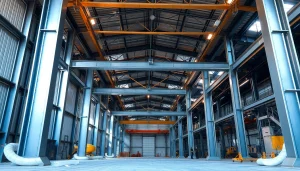Mastering Precision Die Cutting: Techniques for Superior Custom Manufacturing
Introduction to Precision Die Cutting
In the world of manufacturing and design, precision die cutting plays a critical role, allowing for the creation of custom components used across various industries. The process involves cutting materials with high accuracy to meet specific shape and size requirements. Companies seeking to streamline their production processes and improve design accuracy often turn to precision die cutting as a viable solution. This article delves into the intricacies of precision die cutting, exploring methods, materials, benefits, quality control measures, and future trends in the industry.
What is Precision Die Cutting?
Precision die cutting refers to the process of using specialized machines and tools to cut various materials into specific shapes with great accuracy. This technique is characteristically employed in producing components for industries such as automotive, medical, packaging, and electronics. By utilizing custom dies—shaped metal or plastic forms applied in conjunction with high-pressure machinery—manufacturers can create parts with complex geometries and tight tolerances.
Applications of Precision Die Cutting in Industries
The versatility of precision die cutting allows its application across a vast range of sectors:
- Automotive: Used for gaskets, seals, and acoustic insulation parts.
- Medical: Essential for producing components like surgical masks, adhesive pads, and protective covers.
- Packaging: Creates intricate designs for boxes, inserts, labels, and other packaging materials.
- Electronics: Used for producing custom insulation liners, cushioning materials, and circuit components.
Key Benefits of Precision Die Cutting
The benefits of precision die cutting extend beyond just creating custom shapes:
- Efficiency: With automated processes, precision die cutting speeds up production times significantly.
- Cost-effectiveness: Reduces material waste by precisely cutting shapes, optimizing resource use.
- High Accuracy: Delivers exact dimensions and shapes, ensuring compatibility with other components.
- Versatility: Accommodates a wide range of materials, including paper, cardboard, plastic, rubber, and metals.
Types of Precision Die Cutting Methods
Flatbed Die Cutting Overview
Flatbed die cutting is a traditional method where materials are placed on a flat surface. A flatbed press pushes down the die, cutting the material to the desired shape. This technique is notable for its ability to cut large sheets of material and is especially effective for thicker materials.
Common applications include:
- Packaging prototypes
- Manufacturing fabric patterns
- Creating large-scale signage
Rotary Die Cutting Explained
Rotary die cutting utilizes a rotary die designed in a cylindrical form. This die is mounted on a rotary drum, allowing for continuous cutting of materials as they pass through the machine. This method excels at producing high volumes of die-cut parts quickly, making it popular in industries that require mass production.
It is best suited for:
- High-speed production runs
- Adhesives and tapes
- Thin materials like films and foils
Laser Die Cutting Technologies
Laser die cutting employs high-powered lasers to cut through materials with extreme precision. Unlike traditional mechanical dies, lasers can make intricate cuts and engravings without direct contact with the material, reducing the risk of damage.
This method is advantageous for:
- Complex designs
- Material types requiring delicate handling
- Rapid prototyping and short production runs
Materials Used in Precision Die Cutting
Common Materials for Die Cuts
Precision die cutting can accommodate various materials, each offering unique properties:
- Paper and Cardboard: Widely used in packaging and print industries for its versatility and ease of cutting.
- Plastics: Polyethylene, PVC, and PET are common for their resilience and moisture resistance.
- Foams: Used primarily in automotive and industrial applications for cushioning and insulation.
- Metals: Specialty die cutting can be applied to thin metals like aluminum and stainless steel for durable components.
Choosing the Right Material for Your Project
Selecting the appropriate material is crucial for achieving desired outcomes in precision die cutting. Factors to consider include:
- Application Requirements: Identify the functional needs, such as strength, durability, or flexibility.
- Environment: Consider exposure to elements like moisture, temperature, and chemicals that may affect material performance.
- Cost Constraints: Balance material costs with project budgets while ensuring quality is not compromised.
Sustainability in Die Cutting Materials
With growing environmental concerns, the focus on sustainability within precision die cutting increases. Manufacturers are now prioritizing eco-friendly materials, including:
- Biodegradable Plastics: Substituting traditional plastics with biodegradable alternatives to reduce landfill impact.
- Recyclable Materials: Utilizing materials that can be repurposed post-use to promote a circular economy.
- Sustainable Sourcing: Working with suppliers committed to environmentally responsible practices.
Quality Control in Precision Die Cutting
Understanding Die Cutting Tolerances
Precision die cutting demands stringent tolerances to ensure that cut parts conform to design specifications. The tolerances are crucial as they define the acceptable range of dimensions for each part that emerges from the die-cutting process. Typical tolerances might range from ±0.005 inches for intricate designs to ±0.15 inches in standard applications.
How to Ensure Quality in Production
To maintain high quality in precision die cutting, companies should implement robust quality management practices:
- Regular Equipment Maintenance: Routine checks and calibrations of die-cutting machines will ensure consistent performance and reduce defects.
- Material Inspection: Quality checks on incoming materials help catch potential issues before they affect production.
- Operator Training: Skilled operators trained in the nuances of die-cutting processes can significantly enhance output quality.
Measuring Success: Performance Metrics
Establishing key performance indicators (KPIs) can help gauge the effectiveness of the precision die cutting process. Relevant metrics may include:
- First-Pass Yield: The percentage of parts produced correctly on the first attempt without need for rework.
- Production Downtime: Monitoring the time when machines are down for maintenance or repairs to minimize production losses.
- Material Waste Rates: Tracking waste produced during the cutting process to identify areas for improvement and cost reductions.
Future Trends in Precision Die Cutting
Technological Innovations Impacting Die Cutting
The landscape of precision die cutting is evolving, driven by advancements in technology:
- Automation: Increased reliance on robotics and automated machinery enhances production efficiency and accuracy.
- Additive Manufacturing: The integration of 3D printing technologies alongside die cutting opens up new design possibilities.
- Data-Driven Processes: Implementing IoT sensors for real-time monitoring enables predictive maintenance and optimizes operations.
Shifts in Market Demand
Market trends indicate a shift toward personalized and niche products. As customers demand tailored solutions, the adaptation of precision die cutting technology will be essential. This applies to sectors like:
- Medical devices that require bespoke components for individual patients.
- Eco-friendly packaging that responds to consumer preferences for environmentally sustainable products.
- Custom automotive parts for personalized vehicle modifications.
Adaptive Strategies for Businesses
To remain competitive, businesses must adapt to shifts in the industry landscape by:
- Investing in R&D: Fostering innovation through research and development can lead to improved processes and new product offerings.
- Enhancing Collaboration: Working collaboratively with suppliers and partners to develop materials and processes that meet evolving market needs.
- Embracing Sustainability: Committing to green practices will appeal to environmentally conscious consumers and help reduce operational costs.







